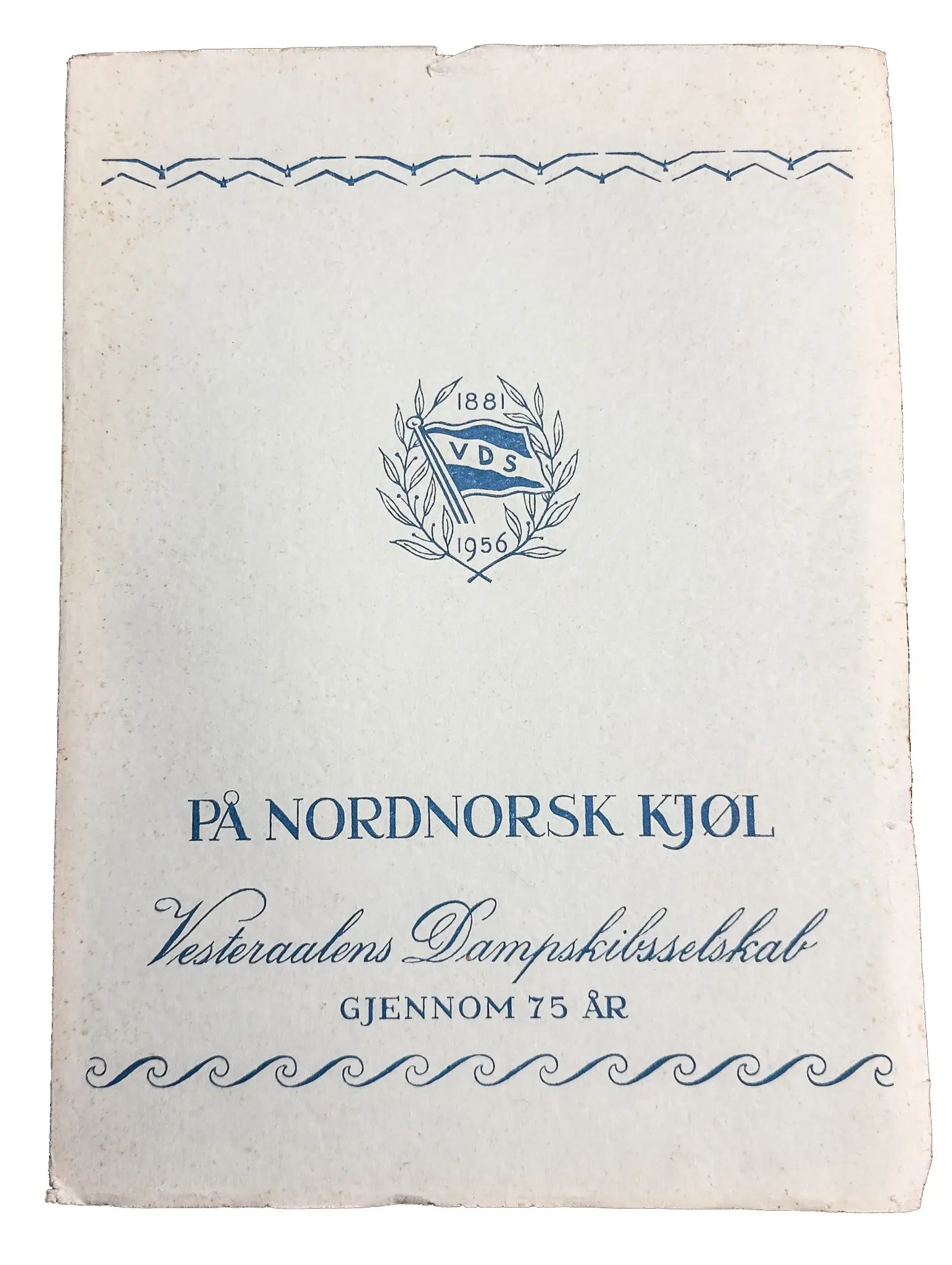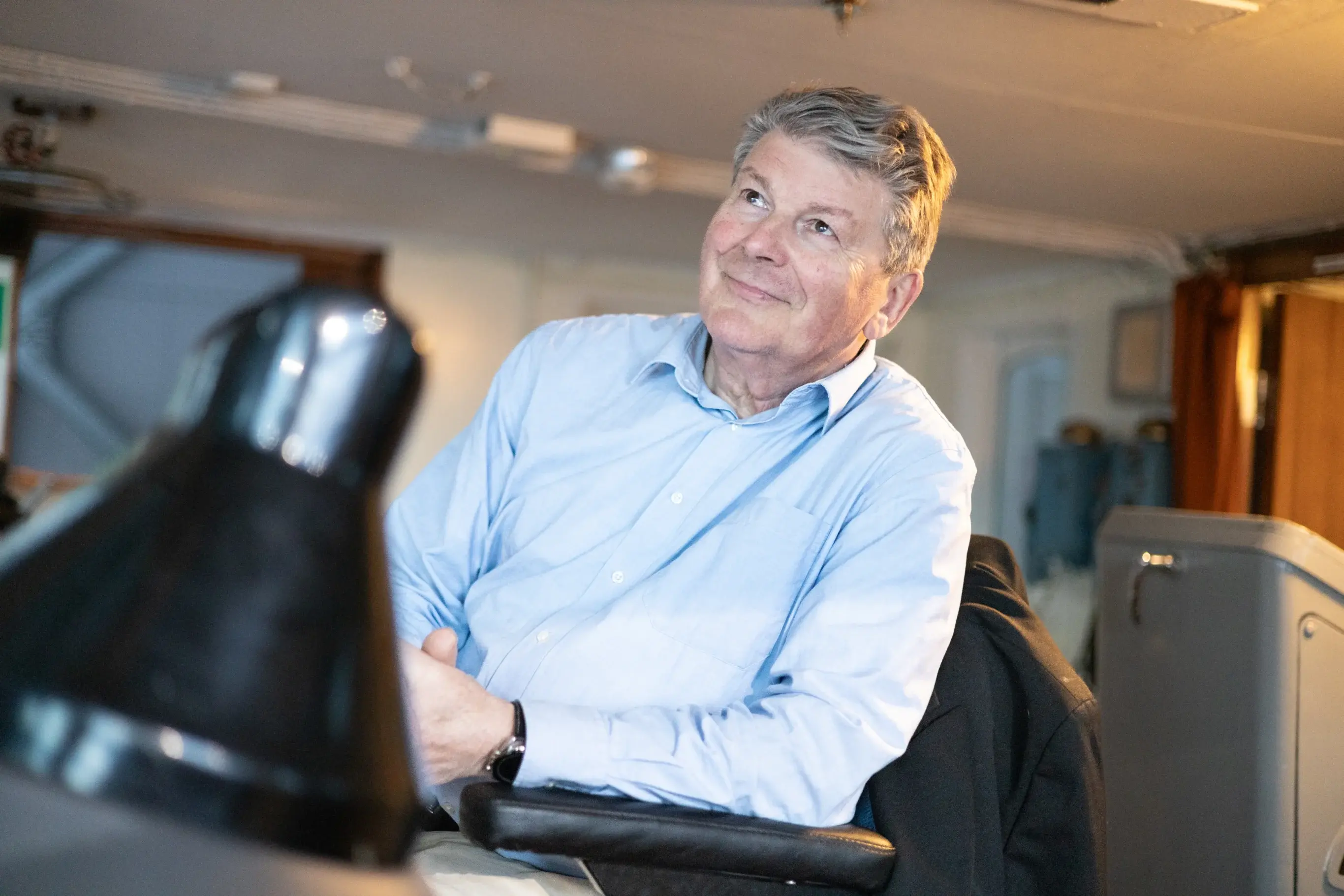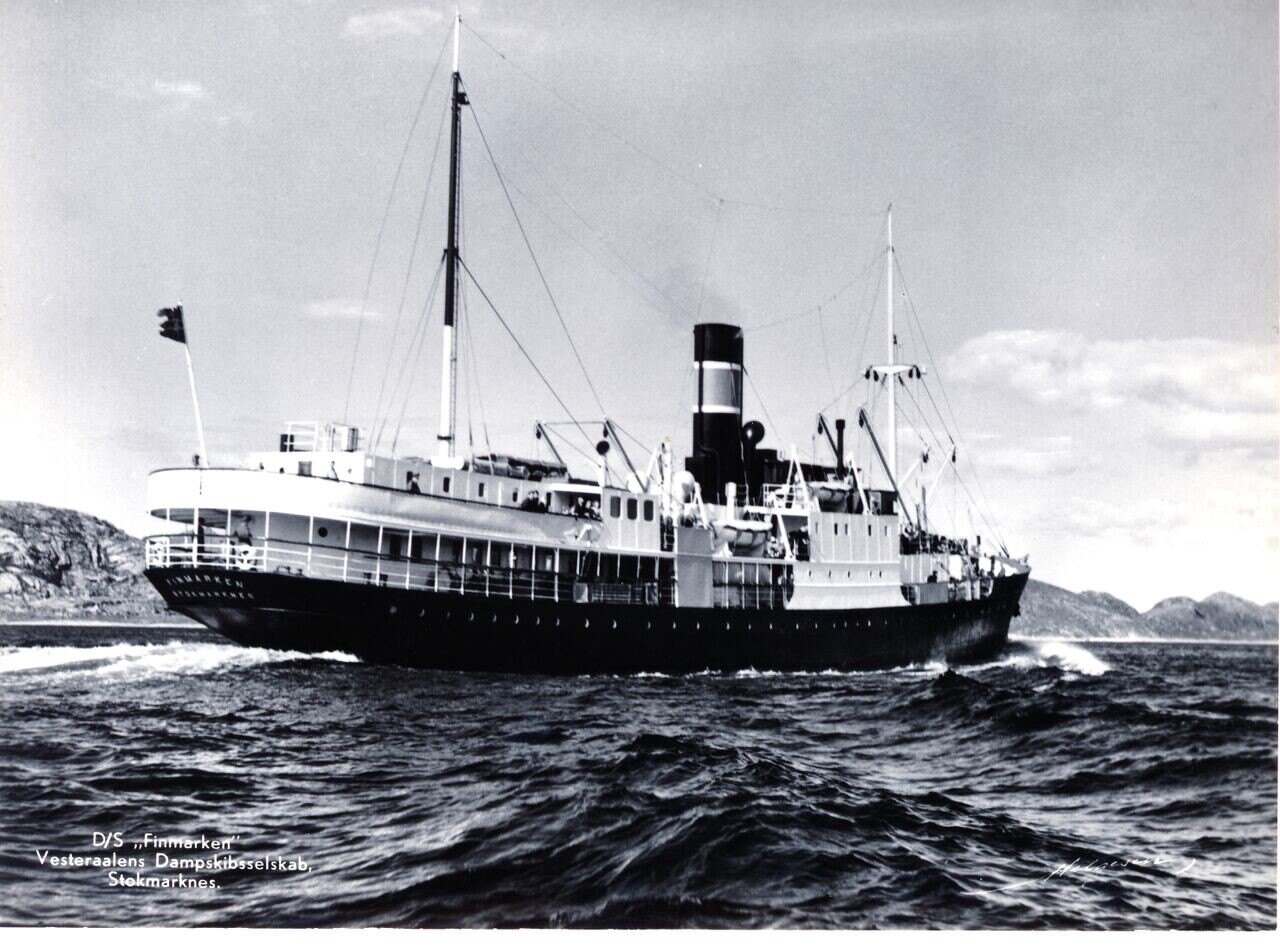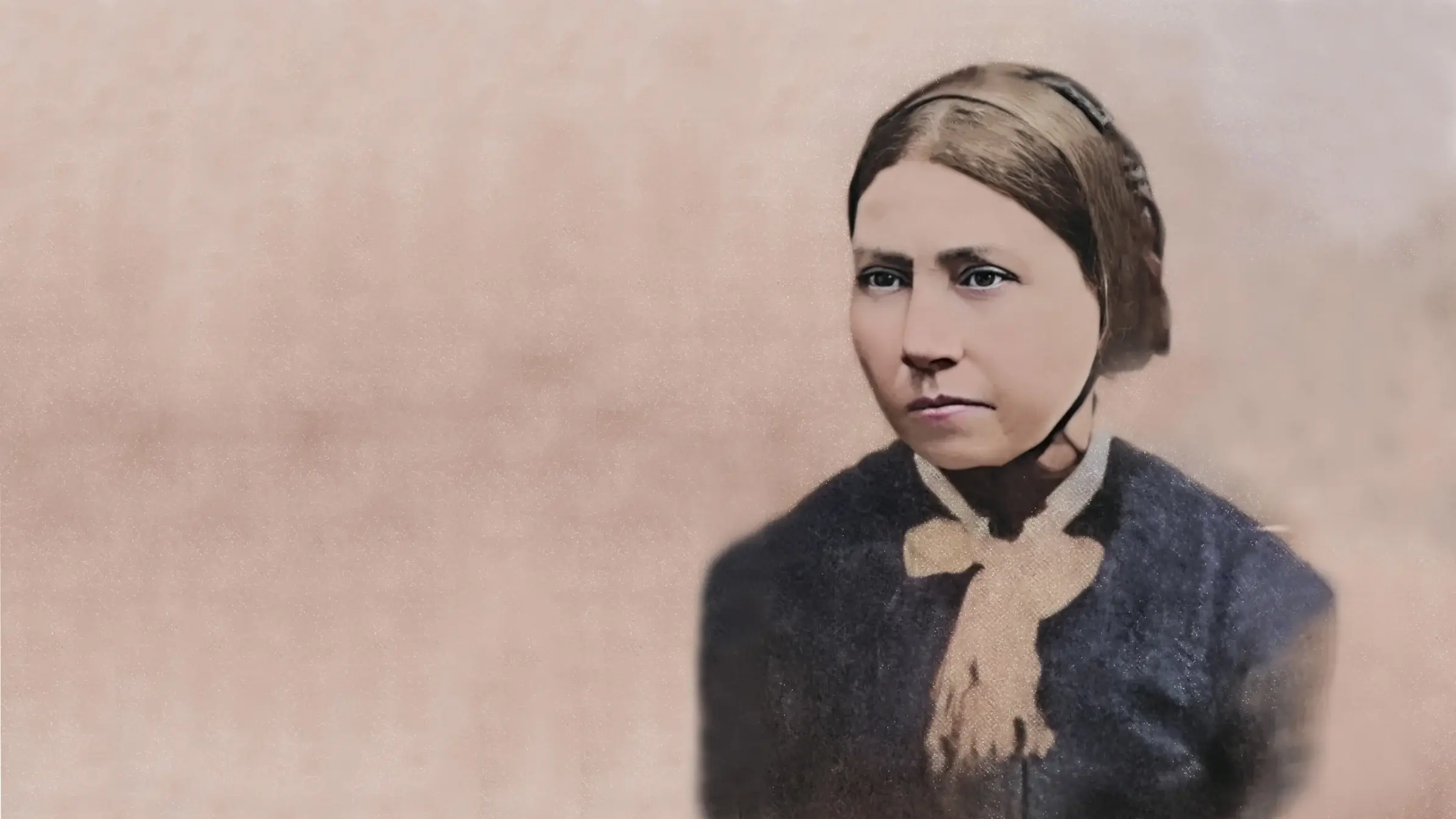The Birth of the Coastal Express
It is the third day of Christmas in 1893. On the open bridge of the steamship DS Vesteraalen, the weathered figures wrapped in fur and leather stand silent, not exchanging a single word. The helm occasionally makes a dry, grinding sound that cuts through the heavy, rhythmic beats from the engine room. One of the men silently moves towards the compass house, which contains an unusually large compass, but otherwise, everything is calm on deck.
As the ship races southwards towards Rystraumen – an undersea stream outside Tromsø – the water is clear, and the lantern at Rystraumen glows faintly red through the snowfall. The Vesteraalen speeds past it at such a high speed that the midship wave breaks over the lighthouse headland.
However, as the ship passes Melangsdypet north of Senja, the swells from the sea enter the fjord. It is already night at this latitude in winter, and the only thing darker than the night itself this evening is the thick smoke swirling out of the ship’s smokestacks, hanging like a thick cloud above the port side of the ship.
"50 minutes. Starboard a bit. Straight ahead," a voice on the bridge says, but there is no light to be seen, and the dark sea ahead is unchanged. The situation appears incredibly dangerous as the ship seems to be sailing blindly. How can it?
The answer to this mystery lies in the wheelhouse, where a logbook written by pilot Anders Holte is situated. Over ten years earlier, Holte stood on the bridge of Captain Richard With's ship, logging the time and location of all course changes on the journey along the Norwegian coast. Although the work was done in daylight, it was revolutionary, and on one occasion, it enabled Holte to navigate the ship safely through a fog bank. He encouraged Holte to complete the work he had started, which made it possible for them to sail in darkness. By the autumn of 1883, Holte had completed his calculations for half the distance between Vesterålen to Bergen.
.jpg)
Pilot, Anders Holte.
As the clock strikes ten, the gale intensifies into a storm, the ship straining and groaning under its force. The few lights dotting the coast along the ship's path are gradually extinguished.
At midnight, the electric lamps on board are switched off. Soon after, however, keen-eyed onlookers catch a glimpse of a piercing light cutting through the dense snow fog. Although the light appears only briefly, it soon reappears, its origin revealed as the lighthouse on Tyvholmen.
Suddenly, the ship's siren pierces the night, cutting through the snow fog, and there, directly ahead, two red lights emerge; the signal lanterns on the quay in Harstad. Then, Vesteraalen gracefully glides past the two lights, until a slight jolt signals its arrival at the quay.
The preceding account is a retelling of a travelogue published in the newspaper "Verdens Gang" in the end of December, 1893. It stands as one of the few, if not the sole, authentic portrayals of the inaugural winter of the coastal express. However, the narrative truly commences nearly half a year earlier, on the morning of July 2nd, when Richard With embarked on his initial coastal express journey from Trondheim to Hammerfest.
Richard With, ‘Father’ of the Coastal Express
Painting by H. W. Jacobsen (1908). The image has been digitally retouched and colourised.
Richard Bernhard With, born on September 18, 1846, in Tromsø, was a reserved and tranquil individual who seldom felt the need to raise his voice in crowds. Indeed, he was a congenial man, grinning frequently. At least this is how Sten Magne Engen, the driving force, daily manager, and chairman of the board for the Hurtigrute Museum, describes the captain. There is no reason to question his assumption, as few living people know more about the coastal route history than Engen. Consequently, he was the first person we approached in our search for source material for this story. We also spoke with Per Rydheim from Sortland in the North, who has a remarkable passion for boats and began delving into this crucial chapter of Norwegian history during his youth. Our resource has been thorough as well, involving hours of reading, to guarantee that we could describe what transpired before, during, and after Richard With's momentous inaugural coastal express voyage 130 years ago, in this pivotal anniversary year of 2023.
«He was musically inclined as well, and enjoyed playing the guitar”, Sten Magne says, as we are having lunch at the Hurtigrute Museum. “This passion for music was shared by his entire family. His daughter, Nanna With, became a piano teacher, and so did her niece, Anna. So when Richard established the coastal route express, it was only natural that musical instruments should be included on the ship!”.
This knowledge motivated Sten Magne to embark on a mission to find a piano just like the one that Richard With installed in the music salon of DS Vesteraalen in 1893, and it took him more than two decades to do so. However, that story must wait for another time. Let us proceed in the correct order...
The Need. In the 1880s, the ships that carried both mail and passengers along the Trondheim-Svolvær route required four to five days for their journey from start to finish, provided that they were not waylaid by delay – a predicament all too common and frequently prolonged. This was hardly unexpected, for the markers on the sea path were inadequate, the maps insufficient, and the lighthouse illumination meagre at best. Nightfall compelled the ships to anchor, and poor visibility thwarted any attempt to navigate. Yet, even as these tribulations plagued the route, the urgency for a swift and dependable transport of mail and passengers became ever more acute.
Captain With was aware of the impact that a reduction in sailing time from Bergen to Tromsø would have on his company, the Vesteraalens Dampskipsselskap (VDS). This was perhaps why, during a visit to the shipyard in Aker where the new D/S Vesteraalen was under construction, he jested that “this vessel must be treated with extra care, as it shall serve as a coastal express”.
In the city of Kristiania (the capital of Norway, now called Oslo), another influential figure, steamship consultant August Kriegsmann Gran, was waging a battle to establish a state-subsidized coastal express route from Trondheim to Hammerfest. He was not the first to bring this issue to the fore. As early as 1868, Governor Nannestad, his colleague in Tromsø, had declared that due to the irregular arrival times of coastal ships, it was impossible to schedule fjord steamers accordingly. He believed that several small, fast ships were needed for mail transport, while freight and passenger transport could be left to private operators. And so, in the summer of 1872, an 8-day route was launched from Bergen to Hammerfest, but with too many ports of call, it did not truly deserve the title of a coastal express route. The Nordenfjeldske Dampskibsselskap (NFDS) and the Bergenske Dampskibsselskap (BDS) were the companies that operated the route. Therefore, it was no surprise that these were the companies Kriegsmann Gran turned to in 1891, urging them to establish a year-round route that would run twice weekly, day and night. The company that could maintain a travel time of 48 hours between Trondheim and Svolvær would receive a government grant of 150,000 kroner per year.
There were no bids. The preeminent steamship companies, NFDS and BDS, shrank from navigating by night. Perhaps they lacked the hard-earned knowledge amassed by Captain With and his cohorts at VDS, inscribed in a book housed in the wheelhouse of the DS Vesteraalen. When the steamship budget was presented to the Parliament in 1892, the Department of the Interior had no recourse but to declare the coastal express route plan to be at a standstill. However, steamship consultant Gran refused to concede defeat, and after traveling through the northern reaches of Norway, where he sought out the counsel of business magnates and ultimately that of Captain With, a revised solution began to emerge. The new coastal express plan, presumably led by Captain With himself, entailed weekly voyages and a travel time of 34 hours between Trondheim and Svolvær, as opposed to the earlier 48.
On September 21, 1892, the Department of the Interior once more issued a request for tender (RTF) for a coastal express route. This time, the call was not exclusive to companies already holding contracts with the government, but was extended to include their competitors, among them, Vesteraalske (VDS). Richard With was prepared, and he was also the only one to submit a bid. VDS offered to take on the contract for a government and postal subsidy of 75,000 NOK, and a contract period of three years. VDS was eventually awarded the contract for a reduced amount of 70,000 NOK.
On January 20, 1893, the Department declared that the proposed arrangement would undoubtedly contribute to significant material development in the north. The fishing industry was to enjoy extra benefits from faster transport between production and delivery sites. Indeed, the North was about to witness a new dawn.
To equip the DS Vesteraalen, originally a cargo ship, for the coastal express route, Captain Richard With envisioned installing several new passenger cabins, postal cabins, and state-of-the-art equipment. True to his word, these were promptly installed, and the first coastal express departure from Trondheim was scheduled for Sunday, July 2, 1893, at 8:30 in the morning. A new era had dawned, and the winds of change had blown into the north, bringing with them prosperity and development.
The First Coastal Express Voyage. Sixty joyful residents from the northern parts of Norway step aboard the DS Vesteraalen. The vessel, bedecked with fluttering flags and gleaming in pristine white, begins to glide away from the quay at Brattøra in Trondheim. These are no ordinary port-to-port passengers, but rather a select group of distinguished guests who have been specially invited to witness the momentous launch of the new coastal express route.
On the bridge, Captain Richard With stands tall, flanked by the seasoned navigators, Paul Hals and F.O. Hegge, and expert pilots, Hans Jensen and Lars Netland. In the engine room, F. Schulze and Ths. Larssen toil tirelessly to ensure the smooth running of the vessel. The postal service is also well-represented by the clerks Lange and Thurn.
The crew of 'Vesteraalen' on the maiden coastal express voyage.
The steamship stops at a total of nine ports of call between Trondheim and Hammerfest, and wherever it goes, the crew is greeted with great enthusiasm. Cannon salutes, horn music, and cheers fill the air, creating an atmosphere of celebration and joy. Flags flutter from painted masts on shore, adding to the festive atmosphere. In towns and trading posts, crowds gather along the docks, dressed in their finest attire, eager to welcome the vessel and its crew.
Still, in most ports of call, the initial encounter with the coastal express is brief and hectic. Frequently, the expedition boats must manoeuvre alongside Vesteraalen in the open sea. While the vessel's engine slows down slightly, there is no time for stopping.
As the coastal express approaches Bodø on the afternoon of July 3rd, it is ahead of schedule by half an hour. The town is bustling with anticipation, eager to pay homage to the ship's officers. Several speeches are made, each one recognizing the captain and his crew. However, as the clock nears two o'clock, it is time for the guests to bid farewell. With the Lofoten Mountains waiting in the distance, Captain Richard With takes his place on the bridge, poised for the next leg of the journey.
For two days, the vessel navigates the treacherous waters, the crew ever-watchful for any dangers that might impede their progress. Finally, the captain signals his arrival in Tromsø with a resounding blast of the whistle, announcing the ship's arrival. The sun shines brightly, and the water is still, as the vessel gracefully glides into the harbor. Lively music fills the air, emanating from the deck of the ship, and the entire city of Tromsø is decked out in flags, celebrating the arrival of the first coastal express ship of its kind.
Captain With and his crew savour four hours in Tromsø before resuming their journey northwards. As the coastal express approaches the harbour of Hammerfest on Wednesday, July 5th, it anchors half an hour ahead of schedule to the sound of a resounding cannon salute echoing through the majestic mountains. The early hour does not deter the crowd, as the harbour is filled with people who have abandoned sleep in favour of witnessing this historic moment. For the next four hours, there is a steady stream of people boarding the vessel, eager to see the interior.
This photo is captured aboard the 'Vesteraalen' upon its arrival in Hammerfest on July 5, 1893."
The guests are impressed by the «luxurious» amenities offered on the coastal express passenger ship. The representative journalist from the newspaper; Finnmarksposten, is particularly intrigued to observe that third-class passengers are not consigned to the cabinets on the intermediate deck, but rather treated to commodious cabins complete with fixed berths. The passengers also have access to their own kitchen, and the electric lighting in both the lounges and cabins augments the atmosphere of indulgence.
Exactly three days after its departure from Trondheim, Vesteraalen turns around, starting its southward journey. An accidental encounter in the Nærøysundet strait yields a historic moment, as the adventurer Fridtjof Nansen's storied polar ship, the "Fram," anchors there to stock up on provisions for its upcoming voyage to the North. Scores of onlookers gather to bid farewell to the ship and its crew, and they also glimpse Vesteraalen sailing gracefully northward through the strait. As she passes by, the coastal express renders a resounding salute to the Fram, punctuated by boisterous cheers, in a display of camaraderie between two vessels venturing forth on their respective odysseys.
Success. Richard With's first coastal express voyage was an unequivocal success. The tight schedule posed no challenge during the long summer nights. However, many sceptics wondered whether the voyage would be as smooth during the treacherous autumn and winter seasons. Some even believed that it would put the lives of everyone on board at risk. Fortunately, reality refuted all dire predictions.
Despite the harsh weather conditions that brought forth storms and darkness, Vesteraalen adhered to its route schedule with remarkable punctuality throughout the winter. The navigation system* that Richard With and Anders Holte had developed and refined during their years in the cargo route industry proved to be a crucial asset. It passed the test with flying colors, ensuring that the coastal express continued to operate with the same efficiency and reliability that it had demonstrated in the summer months.
130 Years of History
The fact that Norway's magnificent coastal route has been in operation for an impressive 130 years is somewhat difficult to grasp. Since the first express sailing in 1893, a multitude of companies have been involved, and at its peak, six different shipping companies shared the responsibility of serving the route. Over the years, the route has been extended several times, with the first coastal express ship, DS. Capella, setting sail from Bergen on October 5, 1898, and Kirkenes becoming part of the route in 1908.
In 2006, when the company Hurtigruten ASA was established, the coastal express route received the official name “Kystruten Bergen – Kirkenes” after a tender from the Ministry of Transport. Havila Coastal Route is the tenth shipping company in line to serve it.
Over the years, the coastal route has had over 60 different ports of call, and today there are 34 ports. The route remains a critical mode of transportation for port-to-port travellers along Norway's coast, while it as also become a popular attraction among domestic and international tourists eager to experience the natural beauty of the Norwegian coast.
Sources
Written sources:
«På nordnorsk kjøl – Vesteraalens dambskipsselskap gjennom 75 år» by Reidar Stavseth
Snl.no
Travel letter from the newspaper Verdens Gang, dated December 27th, 1893, recited in the book «På nordnorsk kjøl»
Oral inspirational sources:
Sten Magne Engen, daily manager, and chairman of the board for the Hurtigrute Museum (on the owner's side)
Per Rydheim, a passionate coastal express enthusiast and hobby historian.




